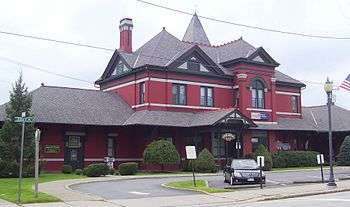George E. Archer

George Edward Archer (February 15, 1853 – December 3, 1903) was an American architect. He became Chief Architect of the New York, Lake Erie and Western Railroad, later the Erie Railroad, in 1886, where he was responsible for planning and supervising the construction of stations, docks, piers an other structures for the railroad between New York and Chicago.[1][2] Several stations built in the late 19th century in New Jersey and Upstate New York are attributed to him.
As a young man Archer was educated at Amesbury, Massachusetts, and later graduated from the Massachusetts Institute of Technology. After working in a variety of jobs – as an architect apprentice, florist, and woodcarver – he moved to New Albany, Indiana, as a bookkeeper for a lumber company. He returned to the east in the early 1880s and worked for the Chief Engineer of the New York & New England Railroad. Later he worked for the Pennsylvania Railroad at Columbus, Ohio. He then worked for the Wilmington & Northern Railroad, until moving to the Erie.[2]
Personal life
Archer was born in New York City, the son of Stephen Durkee Archer and Mary Magray. He married Catherine Henry.[3] He died at home in Nutley, New Jersey, in 1903. He is interred at Laurel Grove Memorial Park, in Totowa, New Jersey.[4]
Erie Railroad stations


- Pavonia Terminal, Jersey City, New Jersey (1887),[5][6][7] razed 1961[8]
- Middletown, New York (1896)[9][10] now Thrall Library (opened 1995);[11] replaced by Middletown Metro-North station in Middletown, New York
- Erie Railroad Depot (Rochester, New York) (1893),[12][13] service discontinued 1941[14]
- Port Jervis, New York (1892)[15] replaced by the Port Jervis Metro-North station
- White Star Line Pier, West Street, New York City.[2]
See also
- Bradford Gilbert
- Frank J. Nies, DL&W Railroad contemporary
References
- ↑ Francis,, Dennis Steadman; (1979), Architects in practice, New York City, 1840-1900 (1979), Committee for the Preservation of Architectural Records
- 1 2 3 Railroad Gazette. Railroad gazette. 1903-01-01.
- ↑ "Archer". Wikitree. Retrieved 2013-05-05.
- ↑ "George E. Archer (1853–1903)". Find a Grave. August 8, 2011. Retrieved 2013-05-05.
- ↑ Middleton, William D.; Smerk, George M.; Diehl, Roberta L. (2007), Encyclopedia of North American Railroads, University of Indiana Press, p. 136, ISBN 9780253349163
- ↑ Erie-Lackawanna Magazine. Vol. 55-57. March 1959. p. 108. Missing or empty
|title=(help) - ↑ Jersey Central Railroad Jersey City Ferry Terminal Johnson Ave. at Hudson River Jersey City Hudson County New Jersey (HAER No. NJ-27) (PDF) (Report). Historical American Engineering Record. p. 16. Retrieved 2013-05-05.
- ↑ "Erie Railroad Terminal". New Jersey City University. Archived from the original on February 4, 2012. Retrieved 2013-05-08.
- ↑ Patrick, Clifton (April 9, 2010). "Erie RR Station". Historical Marker Database. Retrieved 2013-05-05.
1st station used 1843-1896 This bldg, Romanesque style built 1896, George E. Archer, Architect. This RR station served passengers thru 1983
- ↑ "Erie Depot, Middletown, NY". Hagley Digital Archives. Retrieved 2013-05-05.
- ↑ Chumard, Barbara C. (Summer 1996). "Middletown Thrall Library A historical study of a small city public library". www.thrall.org: 48–49. Retrieved 2013-05-09.
- ↑ Berg, Walter C (1893), "Passenger Depot at Rochester, NY New York, Lake Erie and Western Railroad", Buildings and Structures of American Railroads, pp. 389–390, retrieved 2013-05-05
- ↑ Berg, Walter C (1893), "Passenger Depot at Rochester, NY New York, Lake Erie and Western Railroad", Buildings and Structures of American Railroads, Wiley and Sons, pp. 389–390, retrieved 2013-05-05
- ↑ "Erie's Rochester Branch" (PDF). The Semiphore Vol. 52, No.7. April 2010. Retrieved 2013-05-08.
- ↑ "George Edward Archer". New York Sun. 24 Aug 1888. Retrieved 2013-05-05.
Chief Architect Archer, of the Erie, is preparing the plans for the spacious new depot which the Company is about to erect at Port Jervis...Mr. Archer is one of the most experienced architects in the country in this class of work.